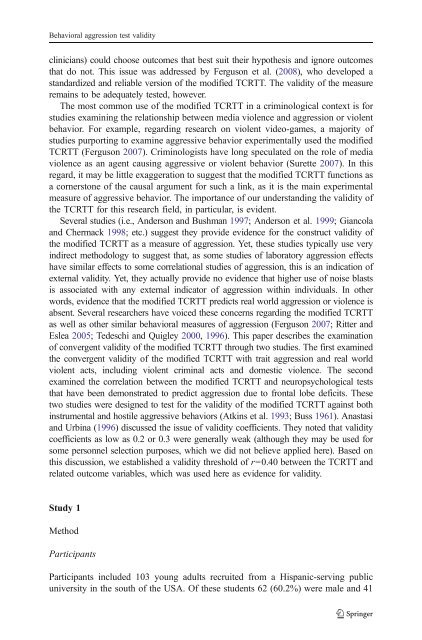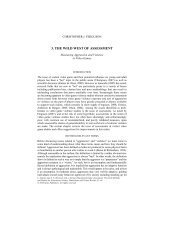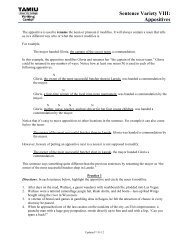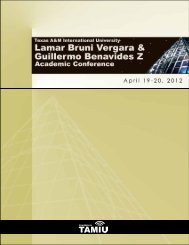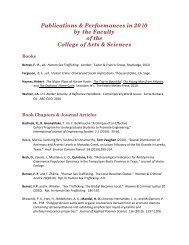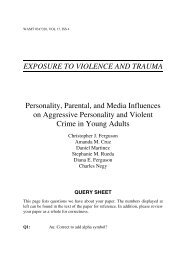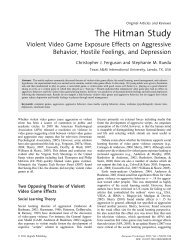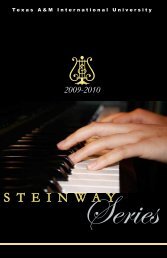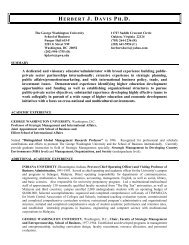Examining the validity of the modified Taylor competitive reaction ...
Examining the validity of the modified Taylor competitive reaction ...
Examining the validity of the modified Taylor competitive reaction ...
Create successful ePaper yourself
Turn your PDF publications into a flip-book with our unique Google optimized e-Paper software.
Behavioral aggression test <strong>validity</strong><br />
clinicians) could choose outcomes that best suit <strong>the</strong>ir hypo<strong>the</strong>sis and ignore outcomes<br />
that do not. This issue was addressed by Ferguson et al. (2008), who developed a<br />
standardized and reliable version <strong>of</strong> <strong>the</strong> <strong>modified</strong> TCRTT. The <strong>validity</strong> <strong>of</strong> <strong>the</strong> measure<br />
remains to be adequately tested, however.<br />
The most common use <strong>of</strong> <strong>the</strong> <strong>modified</strong> TCRTT in a criminological context is for<br />
studies examining <strong>the</strong> relationship between media violence and aggression or violent<br />
behavior. For example, regarding research on violent video-games, a majority <strong>of</strong><br />
studies purporting to examine aggressive behavior experimentally used <strong>the</strong> <strong>modified</strong><br />
TCRTT (Ferguson 2007). Criminologists have long speculated on <strong>the</strong> role <strong>of</strong> media<br />
violence as an agent causing aggressive or violent behavior (Surette 2007). In this<br />
regard, it may be little exaggeration to suggest that <strong>the</strong> <strong>modified</strong> TCRTT functions as<br />
a cornerstone <strong>of</strong> <strong>the</strong> causal argument for such a link, as it is <strong>the</strong> main experimental<br />
measure <strong>of</strong> aggressive behavior. The importance <strong>of</strong> our understanding <strong>the</strong> <strong>validity</strong> <strong>of</strong><br />
<strong>the</strong> TCRTT for this research field, in particular, is evident.<br />
Several studies (i.e., Anderson and Bushman 1997; Anderson et al. 1999; Giancola<br />
and Chermack 1998; etc.) suggest <strong>the</strong>y provide evidence for <strong>the</strong> construct <strong>validity</strong> <strong>of</strong><br />
<strong>the</strong> <strong>modified</strong> TCRTT as a measure <strong>of</strong> aggression. Yet, <strong>the</strong>se studies typically use very<br />
indirect methodology to suggest that, as some studies <strong>of</strong> laboratory aggression effects<br />
have similar effects to some correlational studies <strong>of</strong> aggression, this is an indication <strong>of</strong><br />
external <strong>validity</strong>. Yet, <strong>the</strong>y actually provide no evidence that higher use <strong>of</strong> noise blasts<br />
is associated with any external indicator <strong>of</strong> aggression within individuals. In o<strong>the</strong>r<br />
words, evidence that <strong>the</strong> <strong>modified</strong> TCRTT predicts real world aggression or violence is<br />
absent. Several researchers have voiced <strong>the</strong>se concerns regarding <strong>the</strong> <strong>modified</strong> TCRTT<br />
as well as o<strong>the</strong>r similar behavioral measures <strong>of</strong> aggression (Ferguson 2007; Ritter and<br />
Eslea 2005; Tedeschi and Quigley 2000, 1996). This paper describes <strong>the</strong> examination<br />
<strong>of</strong> convergent <strong>validity</strong> <strong>of</strong> <strong>the</strong> <strong>modified</strong> TCRTT through two studies. The first examined<br />
<strong>the</strong> convergent <strong>validity</strong> <strong>of</strong> <strong>the</strong> <strong>modified</strong> TCRTT with trait aggression and real world<br />
violent acts, including violent criminal acts and domestic violence. The second<br />
examined <strong>the</strong> correlation between <strong>the</strong> <strong>modified</strong> TCRTT and neuropsychological tests<br />
that have been demonstrated to predict aggression due to frontal lobe deficits. These<br />
two studies were designed to test for <strong>the</strong> <strong>validity</strong> <strong>of</strong> <strong>the</strong> <strong>modified</strong> TCRTT against both<br />
instrumental and hostile aggressive behaviors (Atkins et al. 1993; Buss1961). Anastasi<br />
and Urbina (1996) discussed <strong>the</strong> issue <strong>of</strong> <strong>validity</strong> coefficients. They noted that <strong>validity</strong><br />
coefficients as low as 0.2 or 0.3 were generally weak (although <strong>the</strong>y may be used for<br />
some personnel selection purposes, which we did not believe applied here). Based on<br />
this discussion, we established a <strong>validity</strong> threshold <strong>of</strong> r=0.40 between <strong>the</strong> TCRTT and<br />
related outcome variables, which was used here as evidence for <strong>validity</strong>.<br />
Study 1<br />
Method<br />
Participants<br />
Participants included 103 young adults recruited from a Hispanic-serving public<br />
university in <strong>the</strong> south <strong>of</strong> <strong>the</strong> USA. Of <strong>the</strong>se students 62 (60.2%) were male and 41


